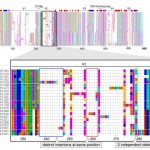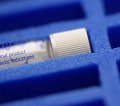 Sciencebase readers will likely be aware that when I cite a research paper, I usually use the DOI system, the Digital Object Identifier. This acts like a redirect service taking a unique number, which might look like this assigned to each research paper by its publisher and passing it to a server that works out where the actual paper is on the web.
Sciencebase readers will likely be aware that when I cite a research paper, I usually use the DOI system, the Digital Object Identifier. This acts like a redirect service taking a unique number, which might look like this assigned to each research paper by its publisher and passing it to a server that works out where the actual paper is on the web.
The DOI system has several handlers, and indeed, that’s one of its strength: it is distributed. So, as long as you have the DOI, you can use any of the handlers (dx.doi.org, http://hdl.handle.net, http://hdl.nature.com/ etc) to look up a paper of interest, e.g. http://dx.doi.org/10.1504/IJGENVI.2008.018637 will take you to a paper on water supplies on which I reported recently.
The DOI is kind of a hard-wired redirect for the actual URL of the object itself, which at the moment will be a research paper. It could, however, be any another digital object: an astronomical photograph, a chemical structure, or a genome sequence, for instance. In fact, thinking about it, a DOI could be used as a shorthand, a barcode, if you like, for whole genomes, protein libraries, databases, molecular depositions.
I’m not entirely sure why we will also need the Library of Congress permalinks, the National Institutes of Health simplified web links, as well as the likes of PURL and all those URL shortening systems like tinyURL and snipurl. A unified approach, which perhaps worked at the point of origin, the creator of the digital object, which I’ve suggested previously and coined the term PaperID, would seem so much more straightforward.
One critical aspect of the DOI is that it ties to hard, unchanging, non-dynamic links (URLs) for any given paper, or other object. Over on the CrossTech blog, Tony Hammond raises an interesting point regarding one important difference between hard and soft links and the rank that material at the end of such a link will receive in the search engines. His post discusses DOI and related systems, such as PURL (the Persistent URL system), which also uses an intermediate resolution system to find a specific object at the end of a URL. There are other systems emerging such as OpenURL and LCCN permalinks, which seek to do something similar.
However, while Google still predominates online search, hard links will be the only way for a specific digital object to be given any weight in its results page. Dynamic or soft links are discounted, or not counted at all, and so never rank in the way that material at the end of a hard link will.
Perhaps this doesn’t matter, as those scouring the literature will have their own databases to trawl that require their own ranking algorithms based on keywords chosen. But, I worry about serendipity. What of the student taking a random walk on the web for recreation or perhaps in the hope of finding an inspirational gem? If that gem is, to mix a metaphor, a moving target behind a soft link, then it is unlikely to rank in the SERPs and may never be seen.
Perhaps I’m being naive, maybe students never surf the web in this way, looking for research papers of interest. However, with multidisciplinarity increasingly necessary in many cross-disciplines it seems unlikely that gems are going to be unearthed through conventional literature searching of a parochial database that covers a limited range of journals and other resources.
 I wrote about the
I wrote about the  Several years ago, I was called on by a multinational producer of hygiene, food, and cleaning products to pay a visit to their research and information centre. My role was to play editorial consultant for content for their new Intranet.
Several years ago, I was called on by a multinational producer of hygiene, food, and cleaning products to pay a visit to their research and information centre. My role was to play editorial consultant for content for their new Intranet. Genetic disease is a complicated affair. Scientists have spent years trying to find genetic markers for diseases as diverse as asthma, arthritis and cardiovascular disease. The trouble with such complex diseases is that they are none of them simply a manifestation of a genetic issue. They involve multiple genes, various other factors within the body and, of course, environmental factors outside the body.
Genetic disease is a complicated affair. Scientists have spent years trying to find genetic markers for diseases as diverse as asthma, arthritis and cardiovascular disease. The trouble with such complex diseases is that they are none of them simply a manifestation of a genetic issue. They involve multiple genes, various other factors within the body and, of course, environmental factors outside the body. I’m not entirely convinced that bird flu (avian influenza) is going to be the next big emergent disease that will wipe out thousands, if not millions, of people across the globe. SARS, after all, had nothing to do with avians, nor does HIV, and certainly not malaria, tuberculosis, MRSA, Escherichia coli O157, or any of dozens of virulent strains of disease that have and are killing millions of people.
I’m not entirely convinced that bird flu (avian influenza) is going to be the next big emergent disease that will wipe out thousands, if not millions, of people across the globe. SARS, after all, had nothing to do with avians, nor does HIV, and certainly not malaria, tuberculosis, MRSA, Escherichia coli O157, or any of dozens of virulent strains of disease that have and are killing millions of people. I am once again drawn to research from a team at the University of Westminster, a renowned institution that doles out so-called science degrees in homeopathy. This time the paper in question, published in the inaugural issue of the International Journal of Food Safety, Nutrition and Public Health (2008, vol 1, issue 1, pp 16-32) is on that perennial favourite: what to do about the
I am once again drawn to research from a team at the University of Westminster, a renowned institution that doles out so-called science degrees in homeopathy. This time the paper in question, published in the inaugural issue of the International Journal of Food Safety, Nutrition and Public Health (2008, vol 1, issue 1, pp 16-32) is on that perennial favourite: what to do about the  Evolutionary science needs debugging. Apparently, there are a few issues that cannot be resolved with any precision when one asks questions like: What makes a human different from a chimp? Apparently, at the level of genetic sequences, systematic errors creep into any analysis, distorting our ancestry.
Evolutionary science needs debugging. Apparently, there are a few issues that cannot be resolved with any precision when one asks questions like: What makes a human different from a chimp? Apparently, at the level of genetic sequences, systematic errors creep into any analysis, distorting our ancestry.

 rVita emailed me today to enthuse about a purportedly “wonderful resource”, which is apparently the web’s first integrative medicine community (funny they should claim that as I had someone else emailing to tell me yesterday about their first such site too).
rVita emailed me today to enthuse about a purportedly “wonderful resource”, which is apparently the web’s first integrative medicine community (funny they should claim that as I had someone else emailing to tell me yesterday about their first such site too).